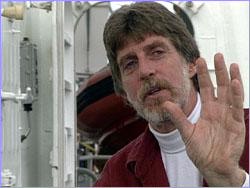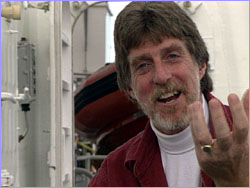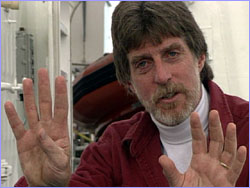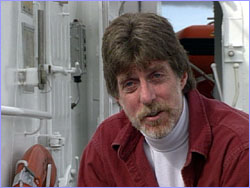
|
 |
 |
 Meet the Team:
Meet the Team:Dr. John R. Delaney Dr. John R. Delaney, the father and leader of this expedition, is a professor in the School of Oceanography, University of Washington. He spoke to NOVA about his hopes and fears for his brainchild as well as about the bigger picture: Why study these chimneys? What can they tell us about how life started on Earth, and how it may exist on other planets? NOVA: Is this a risky endeavor? Delaney: There's always a risk, I think, when you're trying to do something no one's done before. There's not a book we can go to to get the answer, there's no one we can call up and say, "How strong are these things, how easy is it to detach it from the seafloor?" There are no answers. We're going to develop those answers ourselves as we go. On the other side of the coin, though, I'll say there's risk in not doing something like this. The risk is clear. There are a lot of things we wouldn't understand if we didn't try to do something new and different. So there's risk both ways, and I would far rather try and not succeed fully than to have the idea and just not pursue it. NOVA: What was it like seeing your first black smoker chimney? Delaney: The first time I ever saw one of these large sulfide structures was in 1984, and it was absolutely awe-inspiring. It was not just a straightforward chimney-shaped object with billowing black smoke coming out the top. It was draped with a hanging-garden type arrangement of lush animal growth in the form of tubeworms and limpets and snails. It was a stunning experience, and I've never forgotten it. It's as vivid today as it was 14 years ago. NOVA: Why study hydrothermal vent systems?  Delaney: Submarine hydrothermal volcanoes constitute a
very primitive form of system. It is probably one of the most
common systems that existed on the planet throughout much of
its early evolution. There were few continents in the early
Earth, there were few warm, shallow ponds, as Darwin would
suggest life began in. But there were submarine volcanoes and
there was an ocean. So understanding the very basic building
blocks of life and the mechanisms by which those building
blocks come together can be attacked by looking at submarine
hydrothermal systems in a comprehensive way.
Delaney: Submarine hydrothermal volcanoes constitute a
very primitive form of system. It is probably one of the most
common systems that existed on the planet throughout much of
its early evolution. There were few continents in the early
Earth, there were few warm, shallow ponds, as Darwin would
suggest life began in. But there were submarine volcanoes and
there was an ocean. So understanding the very basic building
blocks of life and the mechanisms by which those building
blocks come together can be attacked by looking at submarine
hydrothermal systems in a comprehensive way.NOVA: Why bring up a black smoker? Delaney: There's a great deal that we can learn by simply going to the seafloor, picking up small samples, and bringing them back; there's a great deal we can learn from visiting once a year, maybe once every two years. But to truly understand the system, you must observe how it functions. It would be the equivalent of trying to understand the human body without ever being able to look inside. You couldn't really observe a human and say, "Well, I know how that organism works." They wire astronauts when they put them in outer space, because they want to keep track of how they're functioning. We need to wire the seafloor in order to understand how it functions. NOVA: What will happen when you remove an active black smoker from its site? Delaney: In a sense, this is a controlled experiment, in that when we detach the sulfide structure from the seafloor, we may change the way the entire submarine hydrothermal system behaves. Or we may not. It would be the moral equivalent of removing one of the flutes from a large church organ and hearing everything else go out of tune, because you've plucked the flute. If that happens, we'll get major new insight into the geometry of the fluid flow below the seafloor, which is very difficult to do. NOVA: If you succeed in bringing it to the surface, what will you do with it then?  Delaney: We plan to dissect it. If we're to understand
how submarine volcanoes can support life without sunlight, we
have to dissect those systems and analyze them as thoroughly
as possible, and compare that with information we have about
how they behave. How does the fluid flow through the pores?
How does it deliver nutrients to the system? Those are the
things we're trying to understand.
Delaney: We plan to dissect it. If we're to understand
how submarine volcanoes can support life without sunlight, we
have to dissect those systems and analyze them as thoroughly
as possible, and compare that with information we have about
how they behave. How does the fluid flow through the pores?
How does it deliver nutrients to the system? Those are the
things we're trying to understand.In fact, the insights we'll gain by dissecting the entire structure after having documented it thoroughly in place is one of the most exciting aspects of this whole program for me. Those two keys—thorough documentation in place and thorough dissection—are the heart and soul of this program. We will pore over this thing like no sulfide structure from the seafloor has ever been examined before. This will be the most thoroughly dissected and analyzed piece of rock since they brought back moon rocks. NOVA: Will you do before-and-after studies of the black smokers you're going after? Delaney: To truly make the most of this experiment, we need to be able to make real-time measurements on the seafloor before, during and after the recovery, so that we can see what the effects are. We want to know boundary conditions on what the environment was like prior to recovery. We want to know what the effects are when we actually snap the structure off the seafloor. And we'd like to know how it recovers. NOVA: Could life on Earth have gotten its start in hydrothermal vents, and how will we ever know? Delaney: Ten years ago people laughed when you suggested that life may have originated in submarine hydrothermal systems. They're not laughing anymore. It's still controversial. There's a lot to learn, a lot to be proven. And it's going to be very difficult to truly examine what the origin of life might have been. I don't honestly believe that what we're doing will illuminate that particular issue in a definitive way, partly because it happened about 3.5 billion years ago, and it's a difficult experiment to rerun once life has been spawned on a planet. But to understand the dynamics of the system in which it might have happened is a step in the direction of refining, developing, and throwing out models that either work or don't work. And that's really what science is about—coming up with hypotheses, testing the hypotheses, and dropping like a hot potato the ones that don't make sense or can't fit the data. NOVA: What does the study of hydrothermal vents and their associated life suggest about the possibility of life on other planets?  Delaney: The discovery that life can be supported by
volcanic activity in the presence of liquid water without
sunlight is a profound new insight—new meaning one or
two decades. Also the discovery from some of the NASA programs
that volcanoes are common in the solar system. The combination
of those two insights is a powerful guideline for the search
for life on other planets.
Delaney: The discovery that life can be supported by
volcanic activity in the presence of liquid water without
sunlight is a profound new insight—new meaning one or
two decades. Also the discovery from some of the NASA programs
that volcanoes are common in the solar system. The combination
of those two insights is a powerful guideline for the search
for life on other planets.Recent evidence from the Galileo flight has shown quite clearly that liquid water exists in the subsurface of Jupiter's moon Europa. In my opinion there is also evidence in those images for the presence of volcanic activity below the ice. And so the presence of liquid water and submarine volcanoes, one could argue, is a blueprint for how life may be existing elsewhere. The search for life beyond Earth has been going on for a long time, but I would remind you that exo-biology is the one business for which they have nothing yet to study. The closest that they will come to having something to study for a few years anyway will be, in my opinion, the systems that exist on the seafloor. One of my great dreams, in fact, is that our understanding of the submarine systems here on Earth will guide us unerringly to the discovery of life elsewhere. Interviews: Delaney | Kelley | Mathez | Olson | Shepherd Birth of an Expedition | Mission Plan | Dispatches Through the Porthole | Meet the Team Meet ROPOS (JavaScript/Frames-capable browser required) Meet ROPOS (No Frames/JavaScript) The Mission | Life in the Abyss | The Last Frontier | Dispatches E-mail | Resources | Table of Contents | Abyss Home Editor's Picks | Previous Sites | Join Us/E-mail | TV/Web Schedule About NOVA | Teachers | Site Map | Shop | Jobs | Search | To print PBS Online | NOVA Online | WGBH © | Updated October 2000 |